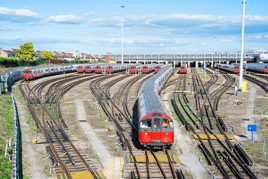Upgrading and modernising the popular and busy Piccadilly Line is one of Transport for London’s top priorities on the London Underground.
More than 10% of all journeys on the Tube are taken on the Piccadilly, whose 44 miles run from Cockfosters in the north to Hammersmith and Acton Town via the West End, where the line then divides into branches to Heathrow Airport and Uxbridge/Rayners Lane.
The fourth busiest line on the Underground, around 200 million trips a year are taken on the Piccadilly, which boasts 53 stations and is the second longest line on the Underground (just behind the Central Line at 46 miles).
But the Piccadilly has more stations than the Central (49), and they are generally closer together. In fact, the shortest distance between two adjacent stations on the Tube can be found on the Piccadilly - between Leicester Square and Covent Garden (0.16 miles).
It is a mainly deep-level line, but with a number of surface sections, mainly to the west.
A £2.9 billion investment programme is under way on the Piccadilly, intended to bring a new fleet of modern trains (built by Siemens Mobility), a new depot and sidings, a power upgrade, improved accessibility, and a crucial new signalling system.
Back in November, the first new train was being put through its paces at Wildenrath (Germany), as part of work to have the fleet ready to begin entering service between 2025-27.
The fleet will be transformed from 86 1973 Stock trains to 94 new ones. The plan is that this will increase the number of trains from 24 to 27 per hour at the busiest times, increasing capacity by up to 23% in the peaks.
However, potential benefits from upgrading the fleet can only fully be realised with Phase 2 of the upgrade, which encompasses a £1.3bn signalling enhancement and a further 18 trains on the Siemens orderbook.
When the first of the new trains was on test in November, TfL Chief Capital Officer Stuart Harvey said: “The most important thing now is that we are making the case to government for the vital long-term capital investment we need to continue with improvements like this, which support jobs and economic growth.
“We want to follow the introduction of these new trains on the Piccadilly Line by doing the same on the Bakerloo Line - replacing the 51-year-old trains that it currently operates, and by continuing to modernise our fleets and signalling to make sure they remain safe and reliable.
“But such vital improvements will not be possible without continued capital investment from the Government from April 2024.”
However, question marks were placed over Phase 2 of the programme, when the Department for Transport awarded London Mayor Sadiq Khan only half of the £500 million capital funding he had requested for the 2024-25 financial year.
While the £250m is sufficient to commit to the new trains, it could significantly delay the signalling upgrade that is vital for optimising their performance.
TfL says this upgrade would further increase service levels (up to 36 trains per hour in the peaks) and provide a 64% capacity boost. But with funding uncertain, so too are the timescales for planned upgrades.
TfL made amendments to its contract with Siemens to enable it to pay for some of the trains later (which will enable other planned improvements to be delivered in the next year).
And a potentially positive consequence is that more of the new trains could be built at Siemens’ Goole factory in Yorkshire, rather than in Austria where they are currently being built.
Currently, the changes aren’t expected to affect the start date of the first new trains carrying passengers, or the intention to increase the number of trains from 24 to 27 per hour by May 2028.
But to understand the real value and importance of the Piccadilly Line to the capital, and why continued investment in these upgrades is so important, we must first understand the line’s roots.
(The history of Piccadilly can be read in a full feature in RAIL 1004 (March 6-March 19, 2024). Get your copy delivered to your letterbox or inbox)
Following the recent confirmation of £250m of Government support for 2024-25, London’s Transport Commissioner Andy Lord said: “While we can now deliver our full Business Plan for 2024-25, our shortfall in government capital investment has only been mitigated in the near term and will reduce the amount of valuable investment we can make in future years, unless further funding is agreed.
“We, alongside London’s business stakeholders and others, will continue to make the case that ongoing government support for capital investment in transport is needed if we are to be able to continue to deliver vital improvements to London’s transport network, unlock new homes, and support growth across London and the UK.”
A truly modernised Piccadilly Line will take commitment to sufficient funding over the next seven to ten years. Currently, the earliest forecast for completion of the signalling upgrade is 2033.
This article is part of a bigger insight feature by Stefanie Foster in RAIL 1004 (March 6-March 19, 2024). Get your copy delivered to your letterbox or inbox.
















Login to comment
Comments
No comments have been made yet.